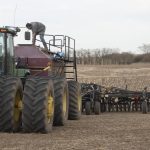If you want to grow peas for their nitrogen benefits then plan ahead and pick the right field. Having a strategy and getting in the ground early can make all the difference, said Therese Tompkins, a coach with Agri-trend and Mark Olson, provincial pulse specialist with Alberta Agriculture.
They spoke about growing peas on a recent Alberta Agriculture crop tour.
They said the ideal seeding depth for peas is about two inches, with a target plant population of eight or nine plants per square foot. Ideally, peas should be planted on fields with low nitrogen. When pulses are grown on a high-nitrogen field, nodules won’t form and production will be poor.
Read Also

Hail research hopes to benefit potato growers
Alberta research scientist measures hail storm and heat dome affects on potato crops
To determine nitrogen rates, Tompkins takes samples from about 12 inches down in the soil the year before planting.
“Last year this field had about 12 pounds of nitrogen left in the soil, which is perfect for peas,” Olson said. “You’re basically negating the whole idea of growing a pulse if you’re putting it on a high-nitrogen field.”
It’s a good idea to rotate pulses and cereals and it’s best to plant a pulse after a cereal crop. There’s also a benefit in planting cereals the year after pulses as the cereal will have a 10 to 30 per cent yield increase following a field pea crop, as well as a one per cent increase in protein.
Weed pressure is another issue in pea crops as Canada thistle cannot be sprayed out of peas. Sow thistle, quack grass and toadflax all need to be cleaned out of the field the year before peas are planted. Planting early and harvesting early makes all the difference in peas.
Peas can be seeded as early as possible, as many varieties are frost tolerant. Early planting can help prevent flower blast, which can occur when the crop flowers above 25 C. Peas harvested in August tend to be better quality than peas harvested in September.
Green peas can bleach if not harvested early. Bleaching on a green pea downgrades the pea to feed, while bleaching on a yellow pea doesn’t result in a penalty.
Ascochyta
Olson said a wet spring with frequent showers can create prime conditions for ascochyta in peas. Ascochyta appears as small, brown spots and reveals itself just before flowering. The disease can devastate a pea crop, resulting in yield losses of up to 75 per cent. Ascochyta breaks down lignins in the stem of the plant and affects the standability of the crop.
Some products can be sprayed once producers see signs of the disease, while others are sprayed at flowering. Other factors, such as the thickness of the crop canopy and leaf wetness at noon, affect the spread of the disease.
Staff at Alberta Agriculture have created an ascochyta score card for producers to determine whether or not they need to spray.
“We don’t want you spraying if you don’t have to spray. If you don’t have symptoms of the disease or the onset, you don’t have to spray,” said Olson.















